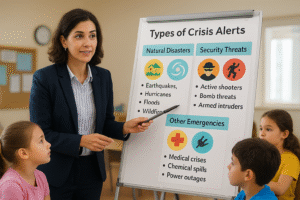News

How Wearable Safety Badges Are Transforming School Emergency Response & Campus Security
In today’s complex and often unpredictable world, school safety has moved far beyond locked doors and routine drills. As incidents of on-campus threats, medical emergencies, and administrative disruptions continue to rise, educational institutions are urgently seeking smarter, faster, and more reliable tools to protect students and staff [Keeping Students Safe: Policies and Practices that Work].
Among the most promising innovations leading this shift is the adoption of safety badges — compact, wearable alert systems that empower school personnel to respond instantly and accurately during any emergency.
This blog dives deep into how safety badges are transforming emergency preparedness in K-12 schools, the problems they solve, and what features matter most when choosing a badge-based alert system.
Why Traditional Systems Fall Short
For decades, schools have relied on a patchwork of alert tools: intercoms, phones, walkie-talkies, and manual lockdown buttons. While these systems served their time, they are no longer sufficient in high-stress, time-sensitive situations.
Traditional communication methods face several limitations:
- They are not always within reach when staff are mobile.
- They lack precision, making it hard to know what type of emergency is occurring.
- They are vulnerable to technical issues (e.g., failed PA systems, dead batteries, or phone lock screens).
- They often lead to delays, confusion, and false alarms.
When seconds matter, these gaps can lead to dangerous outcomes.
What Are Safety Badges?
Safety badges are small, wearable devices designed to help staff send immediate alerts to school administrators, first responders, and other key personnel. Typically worn on a lanyard or clipped to clothing, these badges feature programmable buttons, visual indicators, and sometimes haptic feedback to ensure clear, intentional communication.
More than just a panic button, a modern safety badge is part of a comprehensive emergency response system. It allows users to signal specific types of emergencies (e.g., lockdown, medical, admin assist) and transmits real-time data to a centralized dashboard.
How Safety Badges Improve School Emergency Response
The power of safety badges lies in their simplicity, speed, and clarity. Here’s how they reshape campus safety protocols:
- Faster Response Time
With one-tap activation, safety badges eliminate the need for phones or intercoms. In critical moments, this can mean the difference between safety and catastrophe. - Location Precision
Many badge systems transmit the user’s location instantly, helping responders arrive at the scene faster. - Clear, Color-Coded Alerts
Safety badges can be configured to trigger different alerts: lockdowns, medical calls, or administrative requests. Color-coded systems ensure no one is guessing what kind of help is needed. - Discreet Activation
Teachers or staff can trigger alerts without drawing attention, which is crucial in intruder or active threat scenarios. - False Alarm Reduction
Because badges are designed for intentional use and require distinct physical action, they reduce accidental activations compared to app-based or one-button systems.
Key Features to Look for in a Safety Badge System
Not all safety badge systems are created equal. When evaluating options, schools should prioritize the following features:
- Multi-Alert Capability: Avoid systems that offer only one type of alert. Emergencies are varied; your alert system should be too.
- Offline Functionality: Ensure the system works without relying on Wi-Fi or cellular service.
- Integration: Can the badge system integrate with visual alert hubs, real-time dashboards, or access control systems?
- Battery Life & Durability: Choose devices that are rugged, rechargeable, and long-lasting.
- Ease of Use: The badge should be usable under stress — with tactile feedback, intuitive buttons, and no complicated sequences.
- Real-Time Visibility: Administrators need to see exactly what’s happening, who triggered the alert, and where.
Compliance and Legal Readiness
Many states are enacting laws like Alyssa’s Law, requiring schools to implement panic alert systems that connect directly with law enforcement. Safety badges often satisfy these mandates, but it’s essential to choose a system that complies with your state’s standards.
Training, Adoption & Culture Change
Even the best badge system is only as effective as the people using it. Successful adoption requires:
- Hands-on training for all staff
- Regular drills to reinforce response protocols
- Administrative buy-in and communication to ensure confidence in the system
Safety badges often become more than just a tool — they help shape a culture of vigilance, readiness, and shared responsibility.
A Real-World Scenario: From Confusion to Clarity
Imagine a teacher witnessing a student collapse during class. Instead of running to the office, dialing a number, or shouting down the hallway, she presses the blue medical alert on her safety badge.
Within seconds:
- The school nurse and admin team receive an alert.
- The incident’s location is transmitted to responders.
- Administrator dashboard and badge shows who triggered the alert and where.
No panic. No wasted time. Just action.
Why SimulAlert® Is Leading the Way in Safety Badge Technology
SimulAlert® has redefined how safety badges work in real-world school settings. Our patented color-coded badge system empowers staff to send specific alerts with a single press — without phones, apps, or Wi-Fi. A real-time dashboard gives administrators instant situation awareness.

Figure 1: A staff member wearing SimulAlert® Badge
With SimulAlert, schools reduce false alarms, cut response time, and bring unmatched clarity to emergency situations.
Because when every second counts, your alert system should never leave you guessing.
Ready to enhance your school’s safety?
Click here to schedule a SimulAlert® demo.



